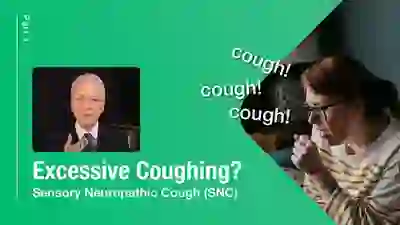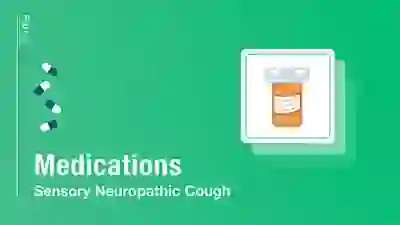Sensory Neuropathic Cough Need Not Be a Diagnosis of Exclusion
Complexification is easy; simplification is the greater challenge.
Introduction
Sensory neuropathic cough (SNC) has been a topic in medical literature since 2006, but it remains for many clinicians a (last resort) diagnosis of exclusion. However, it can be a prima fascia (on the face of it) first diagnosis, made during a first medical consultation for chronic cough. For a person suffering from SNC, this can dramatically reduce the friction involved in getting help, by simplifying both testing and treatment. That is, he or she can move immediately to the appropriate treatment (neuralgia medication), rather than having to wait through years of suffering, unnecessary testing, and misdiagnosis.
Start with Coughing
Where physicians are unfamiliar with SNC, or where they know about it, but still consider it a diagnosis of exclusion, patients undergo unnecessary testing for “the usual suspects” of allergy, acid reflux, cough-variant asthma, post-nasal drip, and the like. And they often pursue a series of empirical trials of medications for these incorrect diagnoses.
The result? Frustrated and often medically-jaded patients, who may continue doggedly taking medications that do not help. Or they may have given up seeking help. An example from my caseload is the patient who had coughed for 10 years; seen 12 doctors; undergone countless tests including many duplications of the same test and tried 40 different medications. The result? Zero benefit.
Hundreds of millions of dollars might be spared worldwide if only SNC could be recognized and treated appropriately upon first meeting it. This would necessitate that physicians schooled in conventional ways of thinking about cough be able to accept the conceptual simplicity and syndromic nature of the diagnosis of SNC. For such physicians, a simple, common-sense approach to the patient can replace a cumbersome, expensive, and time-consuming, approach.
History of the SNC Diagnosis
But some might object, “We are in an age of evidence, “best practice,” and checklists. Where is the proof that SNC is even a real diagnosis? Where is the proof that the conventional testing regime for chronic cough is unnecessary?” An answer is that these things are still emerging, but in the meantime, consider the following experience of the author.
In 2006, after several years of treating hundreds of patients with this disorder successfully, the author was interviewed for a story on a local TV station. This brought his syndromic description of sensory neuropathic cough before a viewership of approximately 200,000 people–not as a prestigious, data-supported, NIH-funded discovery, but as a “new” diagnosis based primarily on long clinical experience with hundreds of patients who shared variations of the same “SNC story” and most of whom had achieved remarkable benefit from use of neuralgia medication.
The purpose was to help people with as-yet undiagnosed SNC recognize themselves in the story, and to then bring the concept to their own physicians, with a request to try one or two of the medications mentioned. The reasoning went, if physicians were willing to try medications empirically for unproven acid reflux, “cough variant asthma,” allergy, post-nasal drip, etc., why not one more empiric trial of neuralgia medication?
What number of viewers took this idea to a personal physician cannot be known. What is known, however, is that within 3 months of the story, approximately 250 individuals self-presented to Bastian Voice Institute for evaluation. Each was frustrated or desperate and often at the same time medically jaded by their years of searching for help, to no avail.
The responses to our detailed cough questionnaire for the first 112 of these patients were placed into a database containing dozens of fields, each one devoted to a datum of interest. Examples: age, sex, number of years since onset, description of sensation initiating the cough and its location, number of doctors seen, number of cough episodes per day, tests and medications tried to date, and so forth.
SNC Patients Find Relief
In response to the explanation of SNC given on local TV, all these patients had correctly diagnosed their condition. Nearly all of them responded to neuralgia medications such as amitriptyline or gabapentin. This leads one to ask:
If patients can match themselves so accurately to a clear description of the syndrome of SNC, couldn’t physicians do the same for those patients who have not yet encountered the diagnosis elsewhere?
As an aside, nearly all of these 112 surveyed patients in their frustrating sojourn through the medical system, had already reached a status that could be called “diagnosis of exclusion.” All had seen several prior physicians across an average of five years. Most had undergone numerous tests, and virtually all had been treated for acid reflux, asthma, and allergy, but none had obtained any relief. It was clear that, had they been armed with an understanding of SNC, physicians could have made the diagnosis years earlier.
Add to this that after finding the author’s teaching videos on Vimeo and YouTube, or written information on Laryngopedia, dozens of people have made contact online to say, “this describes me exactly.” Some have given subsequent feedback after convincing a personal physician to try amitriptyline, desipramine, gabapentin, pregabalin, etc. These contacts have come from not only the U.S. and Canada, but also England, Australia, Brazil, Spain, the Netherlands, and other locations.
What, then, are the Components of the Syndrome?
- A sudden and stereotyped sensory disturbance initiates each episode of coughing. The commonest location of the sensation is midline sternal notch. Others note the sensation at the level of the larynx, or beneath the manubrium, or elsewhere. Typical sensations are:
- Tickle
- Sudden dry patch
- Burning
- Pinprick or “kernel”
- Sensation of dripping
- Sudden feeling of throat congestion
- Vague pressure or bubble
The onset of the sensation is instantaneous. This mimics the rapidity of onset of neuralgia, except that the sensory disturbance is not pain.
- “Trigger phenomena.” In a manner highly analogous to neuralgia, most experience some episodes spontaneously. Examples: while simply sitting and reading a book or engrossed in a movie. But they say that if they _________ (insert action from the list below), they are more likely to cough, or even “that always makes me cough.” Examples of triggers with which one might fill in the blank include:
- Extended talking
- A loud laugh
- Singing especially in upper voice
- Breathing in cold or warm air
- Touching a certain spot on the neck
- Swallowing something vinegary
- Change of position such as when first getting into bed at night
- Number of episodes per day / night is significant. A common scenario might be to cough 30 to 300 times per day, with most episodes lasting a second or two, but several per day lasting much longer: 20 seconds to several minutes. These longer episodes can be violent in some individuals, and associated with runny nose, stress incontinence, retching, and even vomiting or laryngospasm.
- “Mucus” is a red herring. There can be an experience of mucus, but it usually falls into one of the following categories:
- – There is only a sensation of mucus – dripping sensation, etc. Patients can accept that feelings of a pinprick, feather, dust, etc are not the result of an actual pin, feather, or dust. But when they experience a dripping mucus sensation, it can be difficult for them to accept that mucus may not be the actual issue; instead it may be only the sensation of mucus, without actual causative mucus.
- Mucus is produced as a result of the violence of coughing, rather than being its cause.
- The quantity of mucus produced is unimpressive when compared with the
violence and duration of coughing
Not everyone has violent attacks, and in fact some experience mostly repetitive throat clearing, and not that much actual coughing. So, there can be “sensory neuropathic throat clearing.”
- Numerous prior treatments have provided no benefit. To repeat, even though SNC can be diagnosed prima fasciae during a first visit, many patients will in fact have already reached “diagnosis of exclusion” based on prior physicians’ testing and treatments.
Summary
The “usual suspects” (allergy, acid reflux, asthma, etc.) are well established as potential causes of chronic coughing in the minds of clinicians. Primary neuropathic aberrant sensations (dysesthesia) causing sensory neuropathic cough/ throat clearing is becoming better recognized over time. Once introduced to the prima fasciae, syndromic nature of the diagnosis of SNC, both patients and their physicians can be spared from much unnecessary testing and treatment.
And… <wink> … if your physician insists on working through diagnoses of exclusion, suggest that SNC be the first rather than last diagnosis to be considered and excluded! Remember that complexification is easy; simplification is hard.
Share this article

Coughing that Won’t Go Away (Part I)
Sensory neuropathic cough is a chronic cough condition that does not respond to the usual treatments. Many individuals who have been coughing for years find relief from treatment with “neuralgia” medications.

Coughing that Won’t Go Away – Medications (Part II)
Dr. Bastian continues from SNC, Part I and introduces potential medications to treat sensory neuropathic cough.
